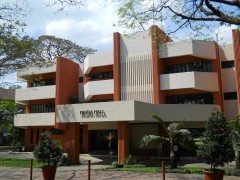Why take B.S. Physics in Ateneo de Manila University: Philosophy and Theology in the Core Curriculum
March 2, 2011 5 Comments
by Quirino Sugon Jr.
I would like to present alternative views on the common perceptions regarding Ateneo de Manila University’s B.S. Physics Program and its allied tracks:
PERCEPTION 1. Ateneo Physics Education has too many core subjects like Philosophy and Theology which are not related to Physics.
The present Ateneo core curriculum requires 12 units of Theology and 12 units of Philosophy, compared to the BS Physics program of UP Diliman which has only 15 units for Philosophy and Social Sciences combined. Of course, there is no Theology in U.P. But UP is already following Ateneo’s lead in the introduction of the more liberal education, because UP realized the need to form holistic persons not narrowminded specialists. And this is seen in UP’s Revitalized General Education Program (RGEP) of 2001.
Back in 1997 when I finished my B.S. in Physics in Ateneo, I took 15 units of Theology and 16 units of Philosophy. In Theology we studied Intro to Theology, Church and Sacraments, Liberation Theology, and Theology of Marriage, and Theology of Commitment. In Philosophy, we studied Philosophy of Man I and II, Philosophy of Religion, and Ethics. The present core curriculum is similar in content, but the class hours was lessened.
Why study Philosophy?
Physics is only part of Philosophy. That is why, when you finish your Ph.D. in Physics, you are called Doctor of Philosophy. The word “doctor” here means teacher, i.e. you can teach the subject. Physics only deals with the physical world: particles, forces, and energy. This is an incomplete picture of the world. Philosophy teaches you about the things that really matter: metaphysics. What is love? What is virtue? What is good? What is it to be truly human? “An unreflected life is the life of a dog,” said Aristotle. It is hubris for a physicist to say that love is just chemical romance, virtue is a neural network trained response, goodness is connected to a particular gene, and to be human is dictated by the overlap integral of Quantum Mechanical wave functions. Once you get these ideas, you lose your love, your virtue, your goodness, and your being human.
Last week, a friend of mine, Dr. Michael Francis Ian Vega (BS Ps 2001) who finished his Ph.D. in University of Florida and is now taking his post-doctorate on General Relativity in University of Guelph, posted a link in his Facebook account. It’s about a physicist (blog.devicerandom.org) who quit the academia (Cambridge University) in order to have his life back:
Top level science requires also an absolutely mind-boggling determination and, overall, confidence in yourself. To properly do science you must be absolutely sure that, whatever you have in mind, you will do it, no matter what, and that you’re doing it right, to the point of almost self-delusion. This is so important that who wins in science is regularly not the most brilliant but the most determined (I’ve seen Nobel prizes speaking and half of the times they didn’t look much more brilliant than your average professor. Most of them were just lucky, and overall were incredibly, monolithically determined). Combined with the above, this means working 24/7, basically leaving behind everything in your life, without any doubt on your skills and abilities and most importantly on your project, while fencing off a competition of equally tough, confident and skilled guys….
There is a second option, which is bare survival. You go from postdoc to postdoc, perhaps end up as a long-term researcher somewhere in some tiny university or irrelevant research center and basically spend your time with a low pay, working on boring projects, crippled by lack of funding and without any hope of a reasonable career (because the career path is taken over by the hawks above described), nor any hope of stability in your life….
Notice that, again, both paths do not offer you any guarantee of sort. You can arrive to tenure track (itself an achievement) and being kicked out after a few years, thus ending up as a jobless 40-year something, with a family probably, too old to compete in the market of real jobs. And bare survival is not easy as well.
So basically, if you are not cut for this kind of life, your chances are zero. I tried, believe me. I tried hard. What happened during my research career is that I spent 6 months on antidepressants, I got a permanent gastritis, I wasted at least two important sentimental relationships, and I found all my interests and social life going down the drain.
This is not the science in the physics textbooks, but the science of everyday life. Many are called into physics, but few are only suited to it–only those with the perseverance of medieval monks who spend all their life perusing old manuscripts in order to find something new. And the sooner you leave the high road of physics in order to find your real vocation as a teacher, an instrument designer, or a government policy maker–to name a few, the happier you will be.
I once saw in TV a theoretical physicist who heads a cloning division. “I want to live forever!” said he. Gollum lived for 500 years seeking for his Precious and look what happened to him: a shriveled mind and body. Philosophy teaches you to accept the reality of death as destined by the Second Law of Thermodynamics: the state of disorder of a system can only increase. Human beings may be made of stardust–remnants of the Big Bang and the formation of stars–yet unto dust they shall return. It is only in the face of death that one knows to be truly human, as my Philosophy teacher once said. Socrates drank the cup of poison, not to commit suicide out of despair, but in obedience to the State whose laws he has obeyed in his youth, and in obedience to the truth that he truly believes: there is life after death.
Why study Theology?
If you are going to browse St. Thomas Aquinas’s Summa Theologiae, you will be surprised that St. Aquinas use physics to explain theological truths. This is not surprising, because his teacher is St. Albert the Great, who was described as “the man who knows everything there is to know”.
For example, in Question 67, Art. 1, Aquinas answers the question whether light is used in its proper sense pertaining to spiritual sense. And he answered in the affirmative. Then in the succeeding articles, Aquinas tried to answer the question on the nature of light. In Art. 2, he says:
Light cannot be a body, for three evident reasons.First, on the part of place. For the place of any one body is different from that of any other, nor is it possible, naturally speaking, for any two bodies of whatever nature, to exist simultaneously in the same place; since contiguity requires distinction of place.
The second reason is from movement. For if light were a body, its diffusion would be the local movement of a body. Now no local movement of a body can be instantaneous, as everything that moves from one place to another must pass through the intervening space before reaching the end: whereas the diffusion of light is instantaneous. Nor can it be argued that the time required is too short to be perceived; for though this may be the case in short distances, it cannot be so in distances so great as that which separates the East from the West . Yet as soon as the sun is at the horizon, the whole hemisphere is illuminated from end to end. It must also be borne in mind on the part of movement that whereas all bodies have their natural determinate movement, that of light is indifferent as regards direction, working equally in a circle as in a straight line. Hence it appears that the diffusion of light is not the local movement of a body.
The third reason is from generation and corruption….
Since, therefore, these things are repugnant, not only to reason, but to common sense, we must conclude that light cannot be a body.
In summary, light cannot be a matter because light can occupy the same place at the same time, its speed is infinite (instantaneous), and it travels both in circular and straight lines. In our modern understanding, light is an electromagnetic disturbance that follows the superposition principle, the speed of light is the maximum possible speed (c = 300,000 km/s), and light propagates as circular waves (see Huygen’s principle) or as particles moving in straight line (Newton’s corpuscles). Until today, no one still knows the true nature of light. The standard Quantum Mechanical interpretation is given by the Wave Particle Duality: light sometimes behave like a particle and sometimes like a wave, depending on how you measure it.
Aside from simply using the concepts of physics as a metaphor for theological concepts, one can also study Theology as the end of Physics. The aim of physics is to find the Theory of Everything, the one equation that shall unify the forces of the universe–gravity, electromagnetic, strong, and weak. According to my physics teacher, Fr. Daniel J. McNamara, SJ, the “Theory of Everything” is an identity equation: “I AM WHO I AM–the ineffable name of God as revealed to Moses. And this leads us to the time before the beginning of time when the world was not:
In the beginning was the Word, and the Word was with God, and the Word was God. He was in the beginning with God. All things came to be through him, and without him nothing came to be. What came to be through him was life, and this life was the light of the human race….And the Word became flesh and made his dwelling among us, and we saw his glory, the glory as of the Father’s only Son, full of grace and truth. (Jn 1:1-14)
The Society of Jesus or the Jesuits, the religious order where Fr. Daniel J. McNamara, SJ, belongs to, is the Church’s largest missionary order who also produced the world’s greatest physicists. Look at the map of the moon and you’ll see that 35 of the craters are named after Jesuits. The more notable ones are Fr. Christopher Clavius, SJ the perfecter of Gregorian Calendar, Fr. Athanasius Kircher, SJ the master of a hundred arts, Fr. Mateo Ricci, SJ the Chinese Imperial astronomer, and Fr. Angelo Secchi, SJ the father of astronomical spectroscopy. Secchi was the inventor of the meterograph which was used in 1865 by Fr. Federico Faura, SJ. of Manila Obsevatory to make the first prediction of Philippine storm. Fr. Faura is the teacher of Jose Rizal in Ateneo de Municipal de Manila which later became the Ateneo de Manila University. In 1965, the first batch of physics majors in Ateneo de Manila University were taught by the Jesuits of the Manila Observatory. So if you study physics at the Ateneo de Manila University, you will become an heir of the long line of the Jesuit scientific tradition.

